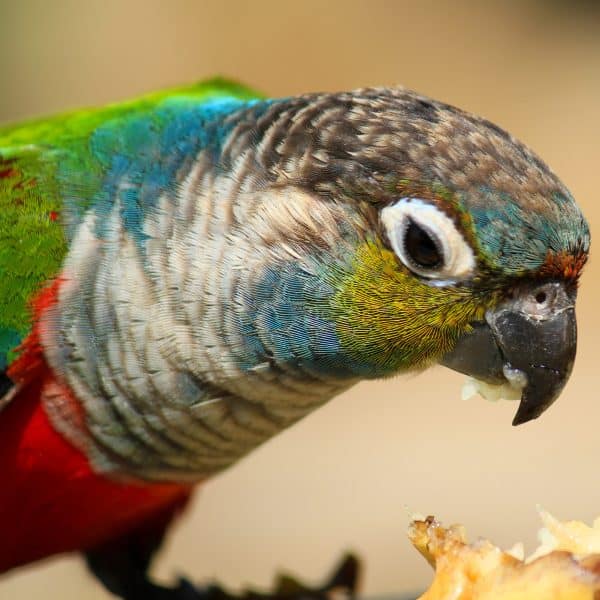
I’m Searching for Some Good African Grey Parrot Bonding Tools
Last Updated on by Mitch Rezman
I’m a new Grey owner… Scarlet came to us on Nov. 24th after spending her first 12 years with one owner, and his wife. She was very bonded to him.
I’m searching for some good bonding tools and would like your advice on some things that I should probably have for her cage and for when she is out, both to play with on her own and interactively with me to aid in our bonding.
Any advice, or books you can recommend would be amazing!! Thank you so much, in advance!! –Gen
Hi Gen
I truly feel your pain. Not sure if you’ve followed our saga of the acquisition of Peaches our Senegal parrot (another African bird – Poicephalus).
Not long after Peaches was weaned she was bought by a man from a breeder who brought her home to his girlfriend/wife who decried the words – “it’s the bird or me.” Words we have heard way too often.
So Peaches was rescued and as rescued birds go they are well cared for but rescues typically are understaffed thus for the seven years she (the rescue had her surgically sexed) got the attention of the rescue staff two hours a day meaning she spent 22 hours a day in her cage alone and did not care for the other large birds in the facility so she spend a lot of time isolated from “the flock” and lived caged, alone in the small bird room.
How Peaches found us is purely providence. The problem is any bird we care for gets put under a microscope – which is something we relish. Far too often do I hear the words “I don’t want to change anything in my birds life because I don’t want to upset him or her”.
We will not allow 108 g of animal (in your case 375 to 450 not knowing if it’s a Timneh or Congo) to dictate its care regimen.
Intelligence does not begin to define the capacity African grays have for learning.
Bird toys serve two purposes in a cage.
They should offer foraging opportunities, enrichment and general interactions to keep away birdie boredom but they should also be used to help provide privacy as parrots are prey birds.
We talk about the bird cage canopy concept here.
And when your bird is out of the cage once again he or she needs places around your home they can call their own.
I’ve given up on books, the information is usually outdated by the time the book is a year old.
We don’t sell them and we are seeking any authors who want to make available e-books on bird care.
If you wanted to write your own series of e-books on your journey with your new African grey I would work with you on that because all of the information we have to date is proving to be obsolete.
When we rebranded Windy City Parrot (after the new website was launched) we replaced the tagline “Simply everything for exotic birds” to “We speak bird @ Windy City Parrot”
In order to know the language of “bird”, you must be able to understand what is being said (viewed by you) to you.
In order to socialize with your bird, you need to “speak bird.”
And I’m not talking about “eyeball pinning” which I see when birds are happy and sad so it tells me nothing.
I’m talking about watching your bird in its cage for hours to understand how it navigates the cage.
I make a point of not necessarily making things easy for bird but I don’t want to make a bird toy inaccessible by putting it in the wrong place in the bird cage.
If a bird eats with it’s feet I will make sure the bird gets large enough pieces of food that it can easily grab with its feet.
If the bird enjoys his or her time on a swing as Peaches does I make sure she has a swings in every cage and on every play stand.
Currently (winter 2016) I have to carry Peaches throughout our apartment as I do my daily domestic tasks – her wings are growing in but she has never flown.
Popcorn our cockatiel had learned to follow me around our apartment and had a place to land in every room that I would be in.
I would talk to her as though she were another person in the room
If you see your African grey for what he or she really is you’ll be on your way to a fabulous relationship. How do you treat an African Grey?
As if you have a three-year-old autistic child covered with feathers. This is what you have to deal with for the next 50 years.
You can make it easy or hard on yourself. Don’t spend a lot of time trying to learn what others have done before you.
Do spend a lot of time trying to understand what your bird is saying and doing.
At the end of the day birds are flock animals and you are their flock.
If you’re playing with the remote while watching TV you best give them something that they can play with similar to a remote.
If you are having dinner with your significant other your bird should be with you on an appropriate standard of some sort sharing the food you eat and engaging in the conversation that you are having at the table. It’s not rocket surgery.
If you can hold your bird, that’s great – if others in your household can hold your bird and interact with it that’s even better.
If your bird is comfortable with you but not so much with others make sure you stick train your bird so that other people can get your bird to step up on a stick/broom handle/dowel perch – and put the bird in the cage should you be preoccupied or unavailable.
Make sure you have a travel cage not only for socialization visits but for trips to the avian vet.
Don’t wait until your bird is sick get to get your bird used to the travel cage. Put him or her in it and take them for a ride.
You want to get the bird comfortable with the ways of humans. That should be your goal.
Best
mitchR
Author Profile
Latest entries
 The Traveling BirdJune 26, 2025Can You Name 5 Parrot Species That Are Living Wild in the USA?
The Traveling BirdJune 26, 2025Can You Name 5 Parrot Species That Are Living Wild in the USA? Bird BehaviorJune 26, 2025How is it Parrots Are Problem Solvers Social Animals and Even Use Tools?
Bird BehaviorJune 26, 2025How is it Parrots Are Problem Solvers Social Animals and Even Use Tools? Bird & Parrot AnatomyJune 25, 2025How a Tiny Chemical Modification Makes Parrots Nature’s Living Paintings
Bird & Parrot AnatomyJune 25, 2025How a Tiny Chemical Modification Makes Parrots Nature’s Living Paintings PigeonsJune 20, 2025How Do Parrots Thrive in Cities Outside Their Native Habitats?
PigeonsJune 20, 2025How Do Parrots Thrive in Cities Outside Their Native Habitats?


